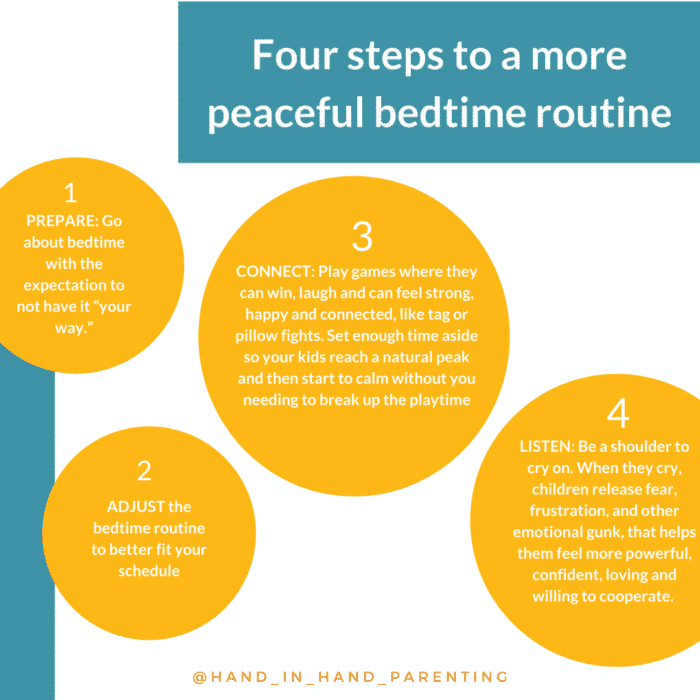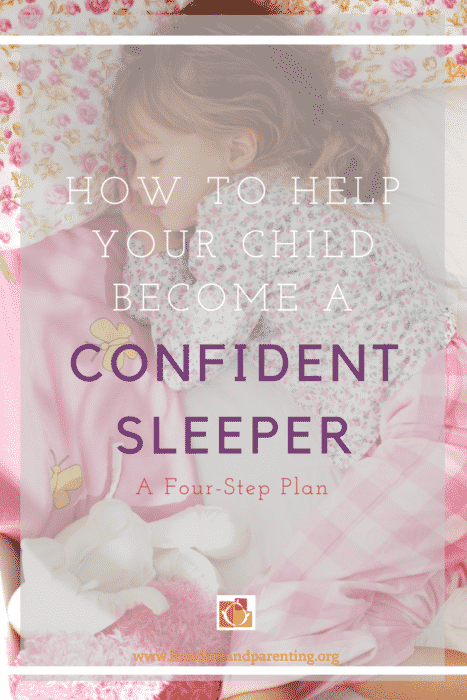A guest post by Irina Nichifiriuc
In our house, I faced a series of “battles” and obstacles every night as the day wore on towards bedtime. With three children, I found that the task of getting them to sleep was getting longer and more difficult as I faced more and more resistance. I began to wonder if I'd ever get them to bed peacefully – and have them stay there.
And, as I tried out new ideas and perspectives, I found that a few small changes made some big differences. Sleep time stopped being so stressful and became a time for all of us to get together and connect before settling down.
Read on, as I share these ideas.
Do We Discredit Valid Bedtime Fears?
But first, why do children resist sleep?
For young children, going to sleep feels like everything that they see, touch, have just DISAPPEARS. To them, you are no more. Your relationship is no more. Who could live like that? Who would willingly give that up?
So, if a child feels disconnected, chances are they will find going to sleep very hard. There is lots in this article on why, despite our generation being more kid-focused that ever, disconnection creeps into everyday life. It could be that you are busier than normal. Perhaps a change has happened – you moved houses, you had another baby or your little one started pre-school. These changes are the more obvious indicators when sleep difficulties happen.
But just as often the fears that rock your child's world, and them anxious about sleep, are not as blatant. Instead, the act of resisting sleep or not sleeping well indicates a presence of fear that may, otherwise, fly under the radar.
Fostering Connection to Aid Secure Sleep
A child that feels safe, in that they are certain of your being here in the morning, who is sure of your love and appreciation, is more inclined to accept the separation that naturally occurs at bedtime.
And so the question is, how do you get there?
Simple Tried and Tested Ideas for A Peaceful Bedtime Routine
These tried and tested ideas have worked wonders in my family, they are simple if a little unexpected.
Prepare
First, PREPARE yourself for this moment. Go about bedtime with the expectation to not have it “your way.” If the last few times your child refused to put on the pajamas, made a big scene when the bed was ready, wanted “just one more story/song” and then another, you can safely assume this time won’t be different.
If you have one, take some time to talk about bedtimes with your Listening Partner. A Listening Partner is another adult with whom you agree to exchange listening time. Basically, you agree to meet on a regular basis and listen to each other without interrupting, without judging and without giving advice, while keeping all you hear confidential. By doing this you get the chance to release emotional tension on a certain subject, and get some perspective and clear your mind so you can be more open to finding creative solutions.
Adjust
Secondly, ADJUST the bedtime routine to better fit your schedule. One thing I did was to read stories in the morning, during the day or weekends and not at night before bed. I noticed that some stories would agitate my children, some would make them ask a lot of questions which I had no time to answer right away and that, in turn, created lots of frustration in all of us. Others would take too long to read, but sometimes, reading simply became one extra thing that stood in the way of a smooth evening.
This is not to say you shouldn't read a bedtime story if it works for you, but do think through any parts of the evening that are stressful and see if you can find ways around them. I decided to keep it simple connect – wash – connect – sleep.
Figure out what works best for your family, what makes your life easier.
Connect
This brings me to the third item but probably the most important – CONNECT.
We know that disconnection brings insecurities, stress, and doubts out around bedtime, so I wanted to see what intentional doses of connection would do to help. I turned to Hand in Hand Parenting Tools to guide me, and became intrigued by this idea of play before bed – something I'd often read not to do!
First I played games that they could win, gave opportunities for laughter, and games were they could feel strong, happy and connected, connected, like tag or a pillow fight.
Once they had played like that for a while, they were more willing to do the bedtime routine. I asked them to get washed up and have their teeth brushed. Then we played the Filling with Love game, that I found in Larry Cohen’s book Playful Parenting.
In this game, each child lays down on their bed and then I, starting from the toes and making my way up to the top of their head, softly touch each part of them and say, “I put a little of my love into the toes, I put a little of my love into the ankles,” and so on. This game only takes a few minutes and it gets them to a calm, cooperative, feeling safe state. I repeated this for each of my children. Even my 10-year-old boy loves it.
Then, it's time to say good night.
I noticed a few things when we started to play. Playing before bedtime did appear to agitate my kids, but it also felt really connecting. Kids that feel connected turn agitation into love, understanding and cooperation, so I wanted to keep going. I realized that if I set enough time aside to play, they would reach a natural peak and then start to calm without me having to break up the playtime. That meant bedtime wasn't the “bad guy” breaking up a good time.
So play! Play vigorously if your child has a lot of energy. Try tag, wrestling, pillow fights, piggyback rides, or dancing. Some games, like hide and seek, give a child a chance to work on separation. Or do Special Time, when you set aside 5-10- 20 minutes to do whatever your child likes while showering your with your love and attention.
My personal favorite game is called Family Time. This is more like Special Time in a group, where every member of the family gets 5 minutes to be the boss. They decide the game and everyone must play it. We end each round with a family group hug. It’s fun, it’s connecting and it gives everyone a chance to be heard, seen and feel important.
Need Game Ideas? Get five of our favorites here
Listen
If your child decides to start crying when it is time for bed, you get the opportunity to LISTEN. Children release fear, frustration, and other emotional gunk, and helps them feel more powerful, confident, loving and willing to cooperate. (I've noticed this myself after a good cry too!)
When I accepted that my child crying was my “friend” not my “enemy,” I found I could actually listen with the intention of offering support – a shoulder to cry on – rather than seeing it as an obstacle, or manipulative. This closeness felt like a gift. I could share the idea that whatever feelings my child had were OK. Hand in Hand Parenting calls this kind of listening Staylistening. You can read more about how it works here.
A Step-By-Step Way To Help My Toddler Transition To Sleeping Alone
When I was ready for my youngest of three to sleep by herself in the same room as her brother and sister she was a little over 2 years old.
 A Week Before: Once I had decided the time was right I told her we would be implementing the change starting the next week, and then I made sure to keep mentioning it from time to time.
A Week Before: Once I had decided the time was right I told her we would be implementing the change starting the next week, and then I made sure to keep mentioning it from time to time.
Night 1: On the first night I explained what would happen. I said I would step outside the door for just one minute to allow her to see how that feels. I told her I wouldn’t close the door, she would be able to see me but I would prefer if she stayed in bed. She cried for 10 minutes in my arms and so I didn’t even get the chance to stand up! I reminded her I needed to be outside the room and I needed her to be in bed. She cried some more with me listening and warmly holding her.
When she stopped crying that time I managed to get to the doorway. She started crying again. I stood there making eye contact and letting her know I wouldn’t be going anywhere. I told her calmly she was alright, that she was safe and that I’d be right back beside her soon. I don't think I stood in the hallway the whole minute before I entered the room again.
I stayed with her some more while she cried. I held her in my arms and told her I loved her, I liked her, that I would be there when she woke up, and that I would come immediately if she needed me at any time during the night. She cried some more and then stopped and asked if I could stay with her while she fell asleep. I told her I would stay near the bed and she fell asleep in less than a minute a slept through the night.
Night 2: The next night things went mostly the same – just with a little less crying.
Night 3: On the third night, I asked if she was ready to try sleeping with the door closed. By that time my daughter had released most of the emotion she had about the transition, and she needed to cry even less.
Night 4: By the fourth night, she said: “You can go do your stuff, I am safe to sleep by myself.”
Why Holding A Limit is Different to Cry-it-Out
Setting a Limit and Staylistening this way is nothing like the popular Cry It Out method. I was right there for her, within eye contact, often within touching distance. Because I had prepared for the transition, in my listening time, and by talking to her about moving to sleep on her own, I could remain calm and supportive while she took that new step toward independence, and I felt confident that she could make it.
I stayed with her as long as she needed me, I listened to her so she would have a chance to “tell” me all about her fear of separation and was there when she was ready to let go. I wanted my demeanor to be warm, and calm, and to suggest to her she was safe, and that nothing bad would happen.
I used the transition as an opportunity to show that I would always be there for her and that I would always love her.
Should We Ever Break A Routine?
Sometimes my kids ask me to stay with them while they fall asleep, or even stay with them through the night, and sometimes I say yes. Routines are good, but breaking them once in a while helps your child know that you can be flexible with some things and that they can trust you to give them love, connection, and healthy limits.
In Conclusion: These Simple Steps Helped Us Feel Closer at Bedtime
These routines are not ones commonly seen on mainstream parenting sites, but they have really worked for our family. They are fairly easy to implement and have helped me in helping my toddler transition to sleeping alone, and in getting my three children off to bed peacefully, with fewer battles.
The Prepare-Adjust-Connect-Listen steps I outlined include the parent as much as the child, and I found it very useful because it lets me shake off my stresses about bedtime struggles and come to my children in a calmer state.
And so while I don't read to them at bedtime, our nights together actually feel much closer. I feel connected to them and I can tell they feel connected to me because they go off to sleep so much easier.
Have you used any of these tools at bedtime? What has worked for you, and what do you find difficult?
Need Game Ideas? Get five of our favorites here
Finally, Stop Bedtime Battles
Find out what stops kids sleeping, how to set limits around sleep and how to build your child’s sleep confidence. Learn more about our online class, Helping Your Children Sleep

